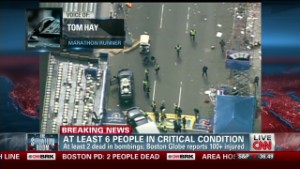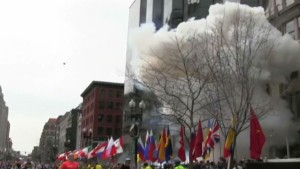Editor's note: Peter Bergen is CNN's national security analyst, the author of "Manhunt: The Ten-Year Search for bin Laden -- From 9/11 to Abbottabad" and a director at the New America Foundation. Jennifer Rowland is a program associate at the New America Foundation.
Washington (CNN) -- It's too early to tell who is responsible for Monday's bombings in Boston. Yet after an incident like this, everyone is looking to find out who did it and why.
One possible guide is recent history: In the years since the 9/11 attacks, dozens of extremists have plotted to use explosives to further their causes in the United States.
Of the 380 individuals indicted for acts of political violence or for conspiring to carry out such attacks in the U.S. since 9/11, 77 were able to obtain explosives or the components necessary to build a bomb, according to a count by the New America Foundation.
 Peter Bergen
Peter Bergen Of those, 48 were right-wing extremists, 23 were militants inspired by al Qaeda's ideology, five have been described as anarchists and one was an environmentalist terrorist.
But in the years since 9/11, actual terrorist bombings in the U.S., like the ones at the Boston Marathon, have been exceedingly rare.
The only bombing attack carried out by an extremist in the United States during the past 12 years was in 2004 when Dennis Mahon, a white supremacist, sent a homemade bomb to Don Logan, the African-American city diversity director of Scottsdale, Arizona, who was maimed when the package exploded in his arms.
By contrast, in the decade before 9/11, the United States saw a number of terrorist bombings -- such as the 1993 truck bomb that killed six at the World Trade Center, carried out by a group of men inspired by al Qaeda's ideology; the Oklahoma City bombing two years later, which killed 168, masterminded by Timothy McVeigh, who was motivated by right-wing extremist ideas; and the 1996 Olympic Park bombing in Atlanta, carried out by anti-abortion extremist Eric Rudolph, which killed one person.
 Investigators look for bomb 'signature'
Investigators look for bomb 'signature'  Marathoner: Blasts 'absolutely surreal'
Marathoner: Blasts 'absolutely surreal'  Watch Boston Marathon explosions
Watch Boston Marathon explosions There are several reasons for the decline in the number of successful bombing attacks by violent extremists in the years since the Oklahoma City bombing.
Almost overnight, the Oklahoma City attacks destroyed the scant credibility of the type of right-wing militia groups that McVeigh had associated with.
The feds also began to pay considerable attention to anyone purchasing large amounts of fertilizer of the kind that was used to construct the Oklahoma City truck bomb.
After 9/11 there was a rapid increase in the number of Joint Terrorism Task Forces around the country, which are made up of multiple law enforcement agencies working together to ferret out suspected terrorist activity.
And following the 9/11 attacks, far more businesses started reporting to law enforcement suspicious purchases of any kind of material that could be used for bomb-making.
As a result, since 9/11 bomb plots that have simply fizzled out have overwhelmingly been the rule.
Around the eighth anniversary of 9/11, for instance, an al Qaeda recruit, Najibullah Zazi, plotted to detonate a number of bombs on the Manhattan subway system.
During the summer of 2009 Zazi, a resident of Denver, obtained a large amount of hydrogen peroxide from a beauty store in Aurora, Colorado. Hydrogen peroxide-based bombs are something of a signature of al Qaeda plots in recent years. The chemical can be used to make the same type of explosives that were detonated during the 2005 London transportation system bombings, in which 52 commuters were killed, a plot that was directed by al Qaeda. Zazi was arrested before he could carry out his plan.
Al Qaeda terrorists have increasingly turned to using hydrogen peroxide-based bombs because it has become very difficult for militants based in the United States and other Western countries to buy conventional explosives.
The plot to bring down as many as seven British, American and Canadian planes leaving London's Heathrow Airport in the summer of 2006 is emblematic of this. A group of al Qaeda-linked British terrorists conspired to manufacture hydrogen peroxide-based bombs, which they planned to smuggle onto flights in soft drink bottles. The plot failed, but a continuing legacy is the fact that passengers cannot bring substantial amounts of liquids onto flights.
Less than a year after the Zazi plot was foiled, on May 1, 2010, Pakistani Taliban recruit Faisal Shahzad tried and failed to detonate a bomb consisting of propane, gasoline and fireworks in an SUV parked in Times Square.
Become a fan of CNNOpinion Stay up to date on the latest opinion, analysis and conversations through social media. Join us at Facebook/CNNOpinion and follow us @CNNOpinion on Twitter. We welcome your ideas and comments.While terrorists working for al Qaeda or allied groups have conspired to launch a number of bombing attacks in the United States in the years since 9/11, right-wing extremists have also been quite active.
In January 2010, Kevin Harpham, a white supremacist, placed a backpack filled with explosives along the route of a Martin Luther King Jr. parade in Spokane, Washington. Fortunately, city workers spotted the suspicious package and police were able to defuse the bomb before the parade began.
Three years earlier the feds arrested a group of men in Alabama calling themselves "The Free Militia" who had manufactured 130 homemade hand grenades.
By contrast to the dozens of right-wing extremists and al Qaeda-inspired militants who have obtained explosives or bomb components, since 9/11 there has been only one case of an environmental militant doing so.
On September 1, 2010, James J. Lee entered the headquarters of the Discovery Channel in Silver Spring, Maryland, with explosives strapped to his chest and guns in his hands. Before he was killed by police, Lee took several people hostage and demanded that more attention be paid to environmental issues.
While the perpetrator or perpetrators of the Boston bombing are as yet unknown, an analysis of the 77 people based in the United States who have assembled bomb-making materials or tried to carry out a bombing for political purposes since 9/11 shows they have overwhelmingly been motivated either by al Qaeda-like ideas or right-wing extremist ideology.
A key to determining who is responsible for the Boston bombings will be the evidence obtained from the two bombs.
If these were hydrogen peroxide-based devices that could be a possible indicator that they were built by an al Qaeda-inspired bomb-maker similar to Najibullah Zazi, the would-be bomber of the Manhattan subway system.
Follow @CNNOpinion on Twitter.
Join us at Facebook/CNNOpinion.
{ 0 comments... read them below or add one }
Post a Comment